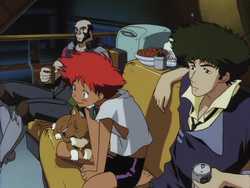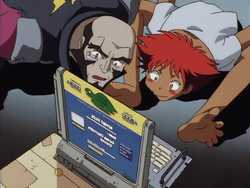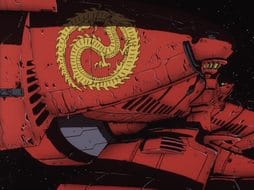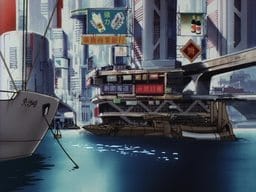The True Language of the Bebop Crew
Today, I want to take a closer look at something that I’ve not yet seen discussed amongst CB fans on the interwebs: the true language of the Bebop crew. We’re not talking about the language of CB as a series or a story - the answer to that is obviously Japanese since it was created by a Japanese production crew in a Japanese animation studio and the original dubbing was Japanese. We’re not talking about the common language used in the space society of the future in which CB is set either; apparently, English is still the lingua franca then and the Bebop crew have proven to be more than adept at dealing with English as a medium (eg. When navgiating the ship's navigation systems onboard the Swordfish II and the Red Tail.)
What I want to look at - what I’m really interested in - is what language the crew onboard the Bebop actually use amongst themselves. What language do Spike, Jet, and Faye default to when they communicate with each other? The answer might not be as obvious as most think.
When trying to get to the bottom of this, one typical starting point is to look at the crew’s ethnicity, and I’ve seen many attempts online at guessing where Spike, Jet, and Faye are from based on their surnames, their looks, etc. But to me that’s a dead end path; having a German-sounding surname like Spiegel doesn’t necessarily make you a German, and looks are such a poor basis to derive any truth (especially when this is anime we’re dealing with). I’ve seen people summarily dismiss the possibility that Jet is Asian because of the way he looks - but if you don’t think someone burly and hairy could be Asian then, my friend, you simply don’t know enough Asians.
So what do I think is the language that the Bebop crew uses amongst themselves? In short: Chinese. More specifically, it looks like they're speaking Cantonese and not Mandarin Chinese. But for the purposes of this essay, let's deal with this in more general Chinese terms. If you want to get into the nitty gritty as to why it's most likely Cantonese and not Mandarin, leave a note in the Comments section and I'll be happy to elaborate.
Anyway, if you pay enough attention the evidence that Spike & co actually default to Chinese amongst themselves is ample. But as is the case with everything that is important in CB, the truth here is never spelled out for the audience, but hidden in the inconspicuous moments, waiting to be discovered.
Let’s run through the signs, both the blatant and not so blatant, one by one. First, the most obvious sign that Spike himself has close Chinese ties is the fact that he was once part of syndicate called Red Dragon, which is not only incredibly Chinese in name, but also in its emblem (see the syndicate’s ship below) and in the attire of its head honchos, The Van.
As an aside, I find it highly amusing that the CB production team named the Red Dragon's capo Mao Yenrai. The Chinese spelling of his name is shown to be 毛恩來 in the scene where he's signing the treaty with the White Tiger syndicate. And anyone with a rudimentary knowledge of Chinese history would notice that 毛恩來 is the portmanteau of Chairman Mao and Zhou Enlai, two of the most famous political leaders of 20th century China.
What I want to look at - what I’m really interested in - is what language the crew onboard the Bebop actually use amongst themselves. What language do Spike, Jet, and Faye default to when they communicate with each other? The answer might not be as obvious as most think.
When trying to get to the bottom of this, one typical starting point is to look at the crew’s ethnicity, and I’ve seen many attempts online at guessing where Spike, Jet, and Faye are from based on their surnames, their looks, etc. But to me that’s a dead end path; having a German-sounding surname like Spiegel doesn’t necessarily make you a German, and looks are such a poor basis to derive any truth (especially when this is anime we’re dealing with). I’ve seen people summarily dismiss the possibility that Jet is Asian because of the way he looks - but if you don’t think someone burly and hairy could be Asian then, my friend, you simply don’t know enough Asians.
So what do I think is the language that the Bebop crew uses amongst themselves? In short: Chinese. More specifically, it looks like they're speaking Cantonese and not Mandarin Chinese. But for the purposes of this essay, let's deal with this in more general Chinese terms. If you want to get into the nitty gritty as to why it's most likely Cantonese and not Mandarin, leave a note in the Comments section and I'll be happy to elaborate.
Anyway, if you pay enough attention the evidence that Spike & co actually default to Chinese amongst themselves is ample. But as is the case with everything that is important in CB, the truth here is never spelled out for the audience, but hidden in the inconspicuous moments, waiting to be discovered.
Let’s run through the signs, both the blatant and not so blatant, one by one. First, the most obvious sign that Spike himself has close Chinese ties is the fact that he was once part of syndicate called Red Dragon, which is not only incredibly Chinese in name, but also in its emblem (see the syndicate’s ship below) and in the attire of its head honchos, The Van.
As an aside, I find it highly amusing that the CB production team named the Red Dragon's capo Mao Yenrai. The Chinese spelling of his name is shown to be 毛恩來 in the scene where he's signing the treaty with the White Tiger syndicate. And anyone with a rudimentary knowledge of Chinese history would notice that 毛恩來 is the portmanteau of Chairman Mao and Zhou Enlai, two of the most famous political leaders of 20th century China.
Getting back on topic, there are, of course, other less conspicuous signs like i) the fact that Faye hails from Singapore, a country where more than three quarters of the population are Chinese by ethnicity, ii) whenever the Bebop crew takes a break from their bounty hunting, they always moor the ship in a part of Mars that looks uncannily like Hong Kong, iii) at planetary gateways, public announcements are made first in English, then in Chinese. Only then, are the announcements made in Japanese and other languages. The order that the languages appear in the announcements, if one is to take such things seriously in an anime (and you could argue that in an anime like Cowboy Bebop, you definitely should), is an indication which are the most common languages in the Bebop universe. This is even more unusual considering that CB was made by a Japanese animation studio. Unusual, of course, unless the production team had done so with intent.
And while we're at it, let's add that iv) even Ein's story begins in Chinatown or what looks like a 1980s Hong Kong. The whole episode is essentially set there and contains direct references to fortune tellers, pet shops, and even garbage trucks - all of which are accurately depicted (and, I should add, tons of fun to watch for anyone from Hong Kong).
Now, the CB production team certainly has a tendency to draw cultural references from all over the world for various sessions throughout the series (Tijuana as backdrop for Asteroid Blues, Istanbul for Waltz For Venus, the wild west for Wild Horses) and using Chinatown as a backdrop doesn't necessarily mean anything. But frequency of usage matters. There's a difference between using Istanbul for one session in a 26-session series, and having repeated Chinese motifs throughout the show. When something occurs often enough in a series, it becomes a theme.
And while we're at it, let's add that iv) even Ein's story begins in Chinatown or what looks like a 1980s Hong Kong. The whole episode is essentially set there and contains direct references to fortune tellers, pet shops, and even garbage trucks - all of which are accurately depicted (and, I should add, tons of fun to watch for anyone from Hong Kong).
Now, the CB production team certainly has a tendency to draw cultural references from all over the world for various sessions throughout the series (Tijuana as backdrop for Asteroid Blues, Istanbul for Waltz For Venus, the wild west for Wild Horses) and using Chinatown as a backdrop doesn't necessarily mean anything. But frequency of usage matters. There's a difference between using Istanbul for one session in a 26-session series, and having repeated Chinese motifs throughout the show. When something occurs often enough in a series, it becomes a theme.
And of course just about any CB fan knows that Spike practices the Chinese martial art of jeet kune do, and that the very first session of the entire series begins and ends with Spike and Jet eating qing jiao rou si, a Chinese stir fry dish of bellpeppers and meat. This wouldn’t have been such a big deal in another anime, but in a series like CB where food is as ubiquitous as smoking and gambling -- both important motifs -- it’s always worth looking at how and what the main characters are eating.
But the above instances, one could argue, are just indications of Spike and Jet’s interests. The two could simply be partial to Chinese dishes and Spike could just be a Chinese aficionado who loves the culture so much that he went and joined a Chinese syndicate. Possible, yes, but not probable.
Let’s see if our favourite femme fatale could shed any light on the matter. Recall Honky Tonk Women, the session where we are introduced to Faye. Where is she when we first meet her? Answer: Chinatown. More specifically, she is in a Chinese pharmacy trying to take cover from the bad guys before launching an attack on them.
Again, this scene doesn’t answer our question about language in any definitive way. Faye could have simply wandered into Chinatown by coincidence while being pursued by the bad guys. But by including a prominent shot with Asian characters “漢方藥局” (“Chinese Pharmacy”), the scene does take us closer to the heart of our subject matter: words as a form of communication.
Let’s see if our favourite femme fatale could shed any light on the matter. Recall Honky Tonk Women, the session where we are introduced to Faye. Where is she when we first meet her? Answer: Chinatown. More specifically, she is in a Chinese pharmacy trying to take cover from the bad guys before launching an attack on them.
Again, this scene doesn’t answer our question about language in any definitive way. Faye could have simply wandered into Chinatown by coincidence while being pursued by the bad guys. But by including a prominent shot with Asian characters “漢方藥局” (“Chinese Pharmacy”), the scene does take us closer to the heart of our subject matter: words as a form of communication.
In the session Boogie Woogie Feng Shui, Jet opens an email from an old acquaintance and the email is… in Chinese.
From this scene, we can be sure that Jet knows Chinese. But perhaps the most telling sign that the Bebop crew communicate in Chinese comes in another scene in Honky Tonk Women. As Spike and Jet are taking the lift to the casino, Jet tells Spike that smoking is prohibited and proceeds to point at a “no smoking” sign. The “no smoking” sign is shown in a multitude of languages, including English and Japanese. Yet the one sign that Jet points out to Spike is… the Chinese one.
From this scene, we can be sure that Jet knows Chinese. But perhaps the most telling sign that the Bebop crew communicate in Chinese comes in another scene in Honky Tonk Women. As Spike and Jet are taking the lift to the casino, Jet tells Spike that smoking is prohibited and proceeds to point at a “no smoking” sign. The “no smoking” sign is shown in a multitude of languages, including English and Japanese. Yet the one sign that Jet points out to Spike is… the Chinese one.
On their own, each of the above moments of Chinese references may not amount to much. But when taken as a whole, the little snippets from their lives start to paint a compelling picture about the default language amongst the Bebop crew. The next time you watch Cowboy Bebop again, consider the possibility that this could well be the story about a Chinese-speaking crew set in an English-speaking world as told by Japanese animators.
[ by Leigh ].
(Update: Here're some additional insights from reader contraptionfour -
"In the backstory as told in The After, one of the Cowboy Bebop artbooks, the Chinese had led the charge away from Earth after the gate accident, and accounted for the majority of the population of Mars (the most powerful colony), so their languages became more dominant, along with their choice of currency. English was intended as a second 'official' language, probably as a holdover from its global standing today. There's a paragraph in The After which sums a lot of this up pretty decisively, and as for the use of English in the series' tech, I've always thought this could be equated to things like Japanese Hi-fi equipment and even their DVD menus often have controls and menu elements labelled in English.
Another point is the herbal medicine scene in Toys In The Attic. Definitely there to illustrate the cultural gap between Spike (of Chinese-dominated Mars) and Jet (from European Ganymede - although even that moon has some Chinese and even Japanese script shown dotted around).
Watanabe also said Singapore was chosen for Faye's background specifically so she would be right at home with the prevalance of Chinese and English in the 2070s."
Many thanks to contraptionfour for this!)
Want to share your thoughts on this essay? Weigh in below:
[ by Leigh ].
(Update: Here're some additional insights from reader contraptionfour -
"In the backstory as told in The After, one of the Cowboy Bebop artbooks, the Chinese had led the charge away from Earth after the gate accident, and accounted for the majority of the population of Mars (the most powerful colony), so their languages became more dominant, along with their choice of currency. English was intended as a second 'official' language, probably as a holdover from its global standing today. There's a paragraph in The After which sums a lot of this up pretty decisively, and as for the use of English in the series' tech, I've always thought this could be equated to things like Japanese Hi-fi equipment and even their DVD menus often have controls and menu elements labelled in English.
Another point is the herbal medicine scene in Toys In The Attic. Definitely there to illustrate the cultural gap between Spike (of Chinese-dominated Mars) and Jet (from European Ganymede - although even that moon has some Chinese and even Japanese script shown dotted around).
Watanabe also said Singapore was chosen for Faye's background specifically so she would be right at home with the prevalance of Chinese and English in the 2070s."
Many thanks to contraptionfour for this!)
Want to share your thoughts on this essay? Weigh in below:
HTML Comment Box is loading comments...












